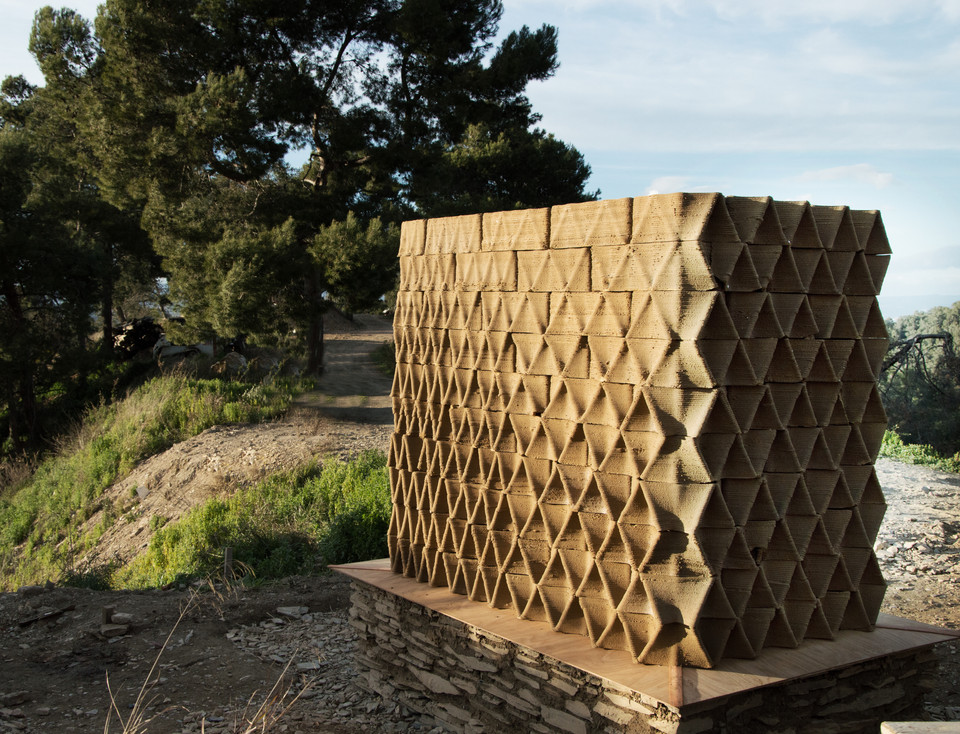
Terra Performa
Clay Additive Manufacturing
Passive Performative Architecture
The project focuses on large scale 3D printing, the influence of additive manufacturing on building with a traditional material - unfired clay - and climatically performative passive design.
Mud constructions are an ancestral technique, based on the use of local material, with an ecological footprint close to zero. It is a material used worldwide, which allows significant winter heating and summer cooling, due to the thermal inertia properties. Additionally, due to the ability to absorb and evaporate, clay offers a self-regulating humidity environment, promoting a healthy indoor climate. By pairing it with contemporary technology, on-site and modular additive manufacturing, the aim of the project is to develop a prototype that states clay as a plausible construction material for architecture, relevant to the developing architectural field.
While 3D printing has given the possibility to create complex geometries, the intelligence of the design comes from the optimization strategies, the creation of performative shapes becoming easier to achieve.
2017
Category: Robotic Fabrication, Material Science
Location: IAAC, Barcelona
Duration: 6 months
Researchers: Sameera Chukkappali, Iason Giraud, Abdullah Ibrahim, Raaghav Chentur Naagendran, Lidia Ratoi, Lili Tayefi, Tanuj Thomas
Directed by: Edouard Cabay, Alexandre Dubor,
Advisors: Areti Markopoulou, Angelos Chronis, Sofoklis Giannakopoulos, Manja Van De Warp, Mathilde Marengo, Grégoire Durrens, Djordje Stanojevic, Rodrigo Aguirre, Kunaljit Singh Chadha, Ji Won Jun, Ángel Muñoz, Wilfredo Carazas Aedo, Josep Perelló, Pierre-Elie Herve, Jean-Baptiste Izard, Jonathan Minchin
Technology: Kuka Robotic Arm
Extrudor: Pylos
Film Production: Lili Tayefi
Music: Glass Animals, Gooey
During TerraPerforma, a series of tests were carried out that explore the possibility to optimize design according to different performance parameters. The development of the project started by researching climatic phenomena and material behavior.
A series of physical tests and digital simulations was done for prototypes of walls testing Solar Radiation, Daylight, Thermal Conductivity, Thermal Convection, Thermal Mass and Structural Behavior. Software such as RHINO CFD, Ladybug, Karamba was used in order to simulate wind, sun and structural behavior. The team also developed a series of machines, such as the Hydrothermal Monitoring Apparatus and the Load Machine in order to further develop their studies, as well as doing a light visualization exercise by recreating sun path with the help of the robot.
In the development of the prototype, the modules are parametrically conceived so to have optimum performance depending on solar radiation, wind behavior and structural 3D printing reasoning, both by their own and as a whole design.
The facade was conceived as a gradient in both horizontal and vertical directions, having various radii of self-shading, in order to optimize east and west sun. Additionally, the modules are designed to incorporate various types of openings, in order to maximize the natural daylight potential – the openings are strategically placed and vary from micro openings to full-openings between bricks are light channels within the challenge of continuous feed printing. The same channels are also designed to aid wind behavior through convection properties, as well as the placement of the micro-perforation which would direct air flow for passive cooling systems.
Material Composition:
The material is a soil based mixture with natural additive specially tailored for AM process with an improved tensile strength and viscosity compared to the traditional soil used in construction.
Printing Technology:
The extruder is composed of a canister with 15 L of capacity for the material, compressed by a pneumatic cylinder. The extruder measures 300x300x2000mm. It allows printing with a layer thickness between 1 and 7 mm, 6 to 30 mm in width, at a speed between 0.05 and 1 m/s.
Prototype 1:
Dimensions: 350 cm length, 25 cm thickness, 20 cm height
Footprint: straight line
Technology: Pylos Extruder / Cable Bot
Location: Montpellier, France
Prototype 2:
Dimensions: 80 cm length, 40 cm thickness, 98 cm height
Footprint: straight line
Technology: Pylos Extruder / Cable Bot
Location: Montpellier, France
Prototype 3:
Dimensions: 285 cm length, 35 cm thickness, 160 cm height
Footprint: L-shape corner wall
Technology: Pylos Extruder / Robotic Arm
Location: Valldaura, Barcelona, Spain
















